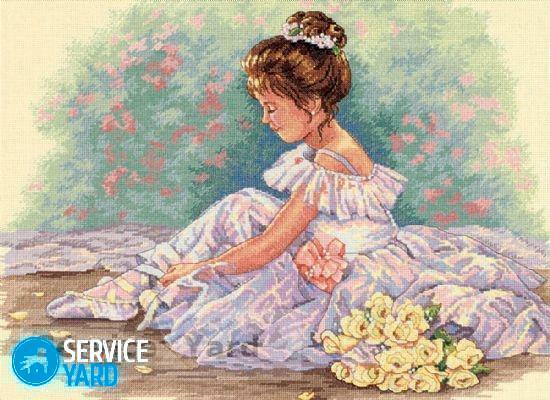
- Why erase the embroidery?
- How to avoid contaminating embroidery?
- What should I check before washing?
- How to wash an embroidery with a cross?
- How to remove stains from canvas?
The long-awaited moment has come and you have finished embroidering your work of art. But this is not the last step. Before you put this creation in a frame, bring your work into an impeccable form, with the help of washing. Do not know how to wash an embroidery cross? Take advantage of our tips.
to the contents ↑Why erase the embroidery?
 Even if it seems to you that your embroidery is not completely contaminated during embroidery, you are strongly advised to spread it before framing. You are sure that you observed all the hygiene practices in the embroidering process. But in any case, you touched the canvas with your fingers and touched the mulina, thereby transferring your fat-and-fat emissions to the picture.
Even if it seems to you that your embroidery is not completely contaminated during embroidery, you are strongly advised to spread it before framing. You are sure that you observed all the hygiene practices in the embroidering process. But in any case, you touched the canvas with your fingers and touched the mulina, thereby transferring your fat-and-fat emissions to the picture.
If you do not wash the canvas, the embroidery will remain grease stains, which will easily attract dirt to yourself, and this will significantly spoil the overall look of the picture.
Important! In some cases, dirt on the product can cause reproduction of the fungus in the picture, which adversely affects the life of the fungus.
Having correctly read the finished embroidery, you can solve such problems:
- will wash out the marking on the canvas;
- will enable the fabric to lie down, to smooth out and flush with threads;
- straighten the fabric;
- remove dust and fine dirt from the threads and linen;
- remove any stains from the fabric on which they were embroidered.
How to avoid contamination of embroidery?
Always follow the simple rules before embroidering the product:
- Wash your hands every time before embroidering.
- Do not drink or eat when embroidering so that drinks and food do not fall on the fabric.
- Cover work when not embroidering - so much less dust settles on it, because this process is often laborious and time-consuming.
What should I check before washing?
To ensure that all colors do not blend into one obscure color, be sure to do the following before erasing the cross-stitch:
- Read the instructions on the packaging with the floss.
- Remove adhesive plaster if you used it when processing the edges of the canvas.
- Remember, if your fingers were not dyed during the embroidering process.
Important! If the threads that you have embroidered are painted with a poor-quality dye, when washing, they can shed and spoil your product.
In this case, to fix the paint, use a solution of acetic acid:
- Wet a piece of cloth with a mortar and pat the area that sheds.
- Take a small basin, pour the solution there.
- Fully immerse the embroidered canvas there.
- Get her out.
- Rinse well under cold running water.
- Start washing.
Important! The vinegar solution will not only facilitate the washing process and help to ensure that your needlework does not fade, but will also strengthen the colors and give them brightness.
to the table of contents ↑How to wash an embroidery with a cross?
In order not to spoil your creation, which you spent a lot of time, observe the rules of washing:
- Wipe the embroidery only in cold or slightly warm water, but in no case in hot.
- Handle only manually, do not rub, do not squeeze or twist the canvas to prevent damage.
- Use detergents that do not contain bleach so as not to damage the color of the floss.
Do you want to emphasize the beauty of your creation? In order for it to look great, follow the following procedure.
Step 1. Wash
- Open the jet of cold water.
- Place the canvas underneath it.
- Drink the product with detergent.
- Rub in circular motions.
- Well wash off the product.
- Hang to make the glass water.
Step 2. Drying
- Take a dry towel.
- Spread out a damp embroidered cloth on it.
- Roll it with sausage.
- Easily iron the towel by hand, do not unscrew it.
- Take another dry towel.
- Repeat this procedure again.
Important! Do not squeeze or twist the embroidery, otherwise you may deform the product.
Step 3. Ironing
- Take the towel.
- Deploy it.
- Place the embroidery face down on the towel.
- Leave, let it dry out a little, but it will not dry out - the canvas should be slightly damp.
- Pull and flatten the embroidery so that there is no distortion of the fabric or pattern.
- Take the iron.
- Set the "Silk" knob on it.
- Move the product over a dry towel.
- Iron from the wrong side.
Important! If your work is done on a fabric made of flax, iron it moist immediately after washing, it will be difficult to smooth it dry.
to the contents ↑How to remove stains from canvas?
 Do not know how to wash the embroidery with a cross on which you left stains while embroidering, and when they are washed they are not removed? Dont be upset! This task can also be easily solved by
Do not know how to wash the embroidery with a cross on which you left stains while embroidering, and when they are washed they are not removed? Dont be upset! This task can also be easily solved by
Method 1
Before erasing the embroidery on which there are stains from blood, do the following:
- Treat stains from blood with hydrogen peroxide or ammonia.
- Collect cool water in the basin.
- Add detergent.
- Wash gently the canvas.
Method 2.
If there are any marks on the canvas from the ballpoint pen, do so:
- Take the glycerin.
- Heat it and add it to warm water.
- Wash the stains with this solution.
Method 3
The tea spot can be removed as follows:
- Take 10% citric acid solution.
- Water it stain.
- Wash cloth in cool water with detergent.
Important! Remove the coffee stain with hydrogen peroxide or refined gasoline. The order is the same.
Method 4
If the canvas is stained with a simple pencil, follow this procedure:
- Take a soapy solution.
- Rub on them the marks from the pencil.
- Pour them on top with ammonia.
- Wash the product in cool water.
Method 5
To solve the problem of how to wash embroidery on which there are marks from a felt-tip pen, use the following tips.
If you have a stain on cotton cloth then:
- Take acetone.
- Heat a little.
- Process the stains from the felt tip.
- Wash the product in cold water with detergent.
Important! If the stain is on woolen cloth, then instead of acetone, use a 2% solution of hydrochloric acid. The procedure is similar.
We hope that our tips are useful and the correct use of them has benefited you. Surely now your work of art will delight the eye for more than a decade.
